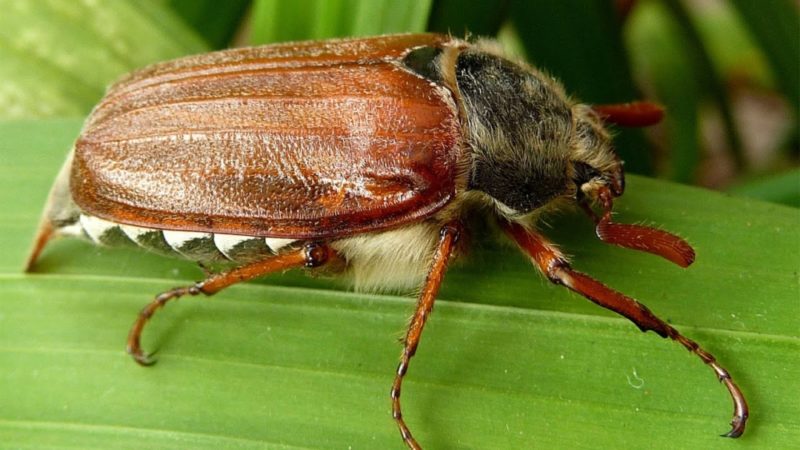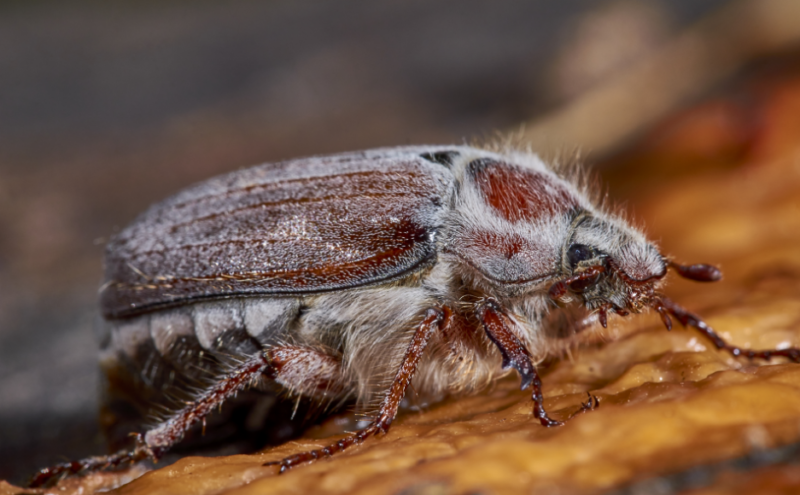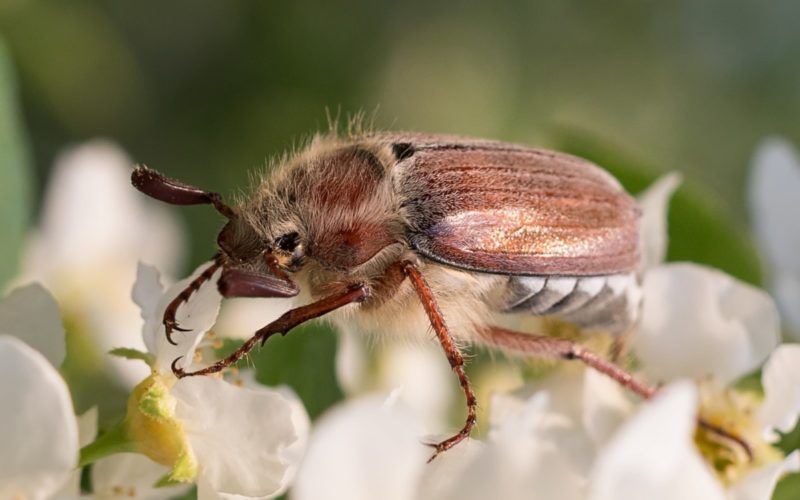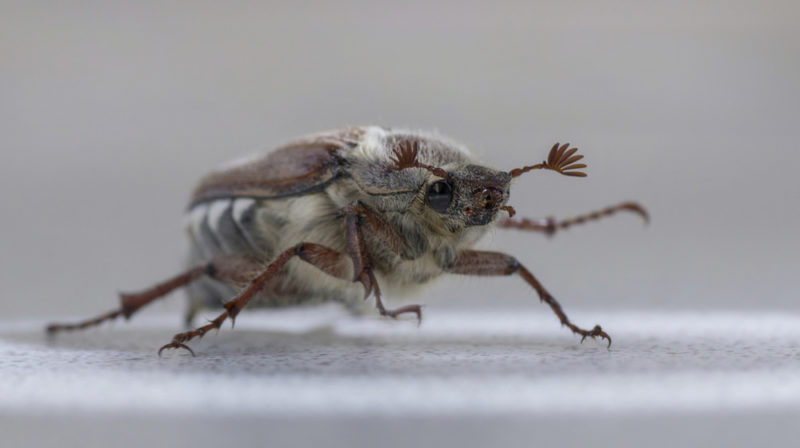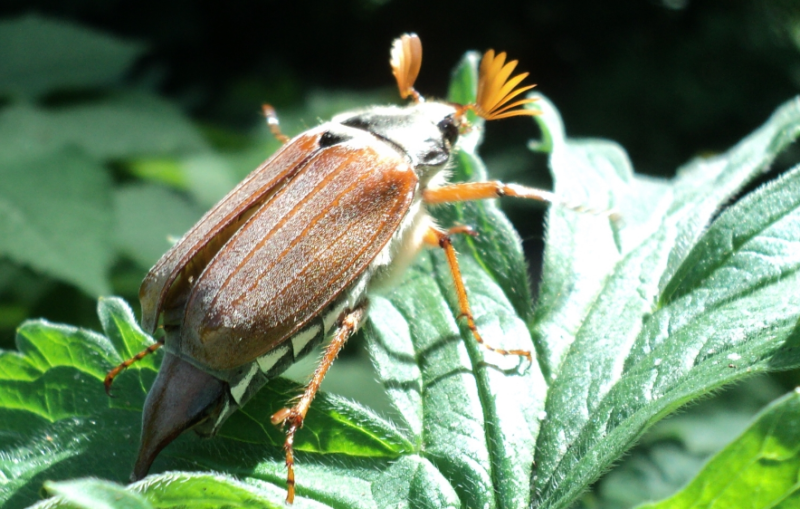Beautiful, just huge insects that have been familiar to everyone since childhood are May bugs. When they fly, there is a loud hum, a buzz that threatens to warn everyone: beware, otherwise I will bite! But these bugs are so big, so harmless for people. The larva of the May beetle is a treasured tackle for any fisherman; a good-quality fish pecks at it. We will talk about these insects in the main content of the publication; they are quite interesting.
Material Content:
Description of the genus and its characteristics
The genus of May Khrushchev belongs to the lamellar family. The “name” got its insect because of the activation of life activity from the last days of April and the beginning of May.
The description of the genus should begin with the structure of the insect body. It is quite large, from 0.17 to 0.32 cm. It consists of 3 parts: head, chest and abdomen. The shape is oval, and the color varies from black to dark brown with a reddish tint, the chitinous shell acts as a protection against injuries.
- The beetle is endowed with elytra protecting the back and lower wings, created for flight. When the beetle takes off, it raises hard elytra.
- The head is small, as if retracted, which makes the insect stoop.
- May beetles are very hairy creatures. The fur covers the body of the insect so thickly that sometimes it hides the main color. The hairs differ in color - in some individuals they are whitish, in others - yellow and even gray. The thickest “hair” is located on the head and chest, and thin, single hairs protrude along the elytra.
- There are small holes on the abdomen of the khrush that are responsible for the intake of air into the body.
- The segmented legs of this insect have three pairs.The front ones are the most powerful, with pronounced parts, on the lower legs there are from 2 to 3 teeth. The other two pairs of legs are thinner compared to the first. The extremities of the beetle are also covered with hairs, they are especially densely distributed in the upper areas. Dense claws, slightly bent backward, are visible at the tips of the legs.
- The eyes of the beetle are convex, of a complex structure - each consists of many simple eyes, which gives the insect sharp vision and a wide viewing angle, which is important when flying.
- The antennae that resemble the Brezhnev eyebrows are located above the organs of vision of the May beetle! They perform the function of smell. A fan-shaped mace consisting of seven plates for males and six for females leaves from the long antennae (10 segments).
- The mouth apparatus of the described insect is a chewing type, namely it allows the beetle to quickly and easily deal with even the strongest and toughest roots. Near the mouth are several pairs of oral appendages. The first was chewing. The second is the lower jaw, and the third, fused, has turned into a lip framed by palps, moving food closer.
Among garden pests, Khrushchev is far from last. Mature species are also dangerous for crops, and their youth are larvae.
- The chitinous dorsal shield is beautiful, glossy, some representatives have a dashed pattern on it. Pygidium (a triangular protrusion at the end of the abdomen) in males is more developed, in females - weak.
Many confuse the May bug with another, no less large, green, and call it bronze. Meanwhile, these are completely different species, and the description of the grubber proposed in the article will allow you to distinguish between them.
Which detachment belongs to the insect
Khrushchev belongs to the order of beetles. These are insects in which the front wings have changed from soft webbed to hard leathery elytra. Under them are thin wings that allow you to fly.
Elytra close to each other, are at rest. When the insect needs to take off, they rise, and remain in this position until they land.
Otherwise, the order of beetles is called bugs, and it is the most numerous among insects, has more than 390 thousand species!
May Khrushchev Habitat
Beetles are common throughout the planet. They are in the CIS countries, in Russia, throughout Europe, in Indonesia, Japan, Syria and so on. Zones of rivers, forests, parks and vegetable gardens — all where there is soft and loose soil — serve as the habitat of the khrushch.
If clay prevails in the soil, the beetle will not settle in it, because despite its size and power, the female is simply not able to dig tunnels in hard ground to lay eggs.
For living, the insect chooses the rhizomes of trees covered with deciduous soil - food for themselves and future offspring. By this, beetles cause irreparable harm to plants, they can destroy them.
Lifestyle and methods of transportation
In early spring, when the first leaves begin to hatch on tree branches, the male half of the May beetles that creep out of the larvae crawl out of hibernation. About ten days they wait for the awakening of the females. The species begins an active life after twilight, comes to the surface in search of food. For the most part, beetles feed on their shelters, and produce provisions by flying about 20 km a day.
Despite long distances, bugs spend no more than 40 days in their entire lives in flight, as they move quickly, at a speed of up to 11 km / h.
In the habitats of the May Khrushchev, where whole colonies live in the roots of the trees, one can see many gnawed leaves and waste products.
As the flying beetle moves, a strong hum is heard, buzzing. It seems like a helicopter is about to appear from behind the clouds. But this is just a large insect.
What do beetles and its larvae eat?
May bug feeds on both wild-growing and cultivated plants.
- The basis of the diet is color, foliage, juicy twigs and bark.
- Most of all, the insect loves to eat plums, apple trees, cherries, from shrubs - gooseberries, sea buckthorn and black currants.
- Among the wild plants, the beetle will choose birch, oak, poplar, mountain ash, maples, chestnuts, aspen, hazel, willow, linden and beech.
More serious damage to crops is not caused by the grubbers themselves, but by their voracious larvae that feed on egg laying sites for 3 to 5 years. In the first year, the cub does not pose a threat to the plant, as it feeds on grass roots and humus. From the second year of life, the roots of young bushes and trees begin to move into the course.
Sweet root vegetables such as potatoes, beets and carrots are considered to be the favorite delicacy of young animals. They will not refuse the pleasure of enjoying the roots of corn, strawberries, and onions. Coniferous forests especially suffer from these creatures - gluttons absorb the roots of larch and pine trees.
If the May bug began to host in the garden, you need to urgently get rid of it.
The gluttonous family is destroyed by the following insecticides:
- "Zemlin";
- Bazudin
- "Antichrush."
Funds are introduced into the soil when planting plants, and they also carry out treatment for the prevention and control of insects.
You can secure your landings by other methods:
- Weed the soil, loosen, clean the found larvae.
- During the autumn digging of the site, add bleach and whiteness.
- Near fruit crops, plant a white clover. The roots of this plant accumulate nitrogen, which repels pests, but is useful for plants.
Put birdhouses on the plot. Ptahs with pleasure will dig out larvae and beetles from soil.
Propagation of the lamellar family
From the end of May, Khrushchev begins to multiply actively. After the weddings, the female lays the first 20 to 30 eggs in the roots of the plants. Buries them and returns to continue mating. During the season, one female brings offspring 3-4 times, and the total number of eggs reaches 40-60, or even 70 pieces. After that, the mother dies, and the children do not need her further presence.
- In a month - one and a half eggs are opened, and from them appear larvae - large, plump, with a large mouth. For the next three years in this state, the insect will actively develop, deepening by 1.5 m in winter, and in spring returning to the upper layers of the soil.
- At 3 years (in the southern latitudes) or 4 (for regions with a harsh climate), in mid-summer the larva passes into the pupal stage, and this period lasts about a month and a half.
- Next, the chrysalis turns into an adult beetle, and continues to remain in a nap until spring.
- In April - May, a tunnel breakthrough, males climb to the surface, then females catch up with them. And the cycle begins again: mating, feeding, laying eggs, the death of the female, and then the male, the development of the larva.
Life span
The development of the May beetle is a long, but full-fledged existence is short. The total life cycle reaches 5 years, of which only one summer (about 2 months), the raspberries are active.
Let us consider in detail the life stages of a beetle:
- 30 - 40 days - the stage of the egg;
- 3 - 4 years - stage of the larva;
- 1.5 - 2 months - pupal stage;
- adults (full-fledged beetle) - about a year, from which the insect is awake only 5-7 weeks.
During this entire cycle, a family living in the roots of a plant can completely destroy an adult tree. Therefore, people are actively using chemicals to fight the scrub.
Interesting facts about the May bug
Not one of its beautiful appearance is interesting in this creation.
The insect even perplexed scientists with the fact that:
- It should not fly, in principle, it has insufficient lift. But, despite all the laws of aerodynamics, the bug flies, and even very smartly.
- Anyone can envy the sense of purpose of a horsetail. It is simply impossible to disorient him. If the insect has outlined the goal, then it will only prevent him from killing. Catch, release in another place, treat it with chemicals or unfold. Having returned to freedom, having come back after influences, the bug will return to its previous course!
- The larva for the third year is so voracious that during the season it can dig up the whole pine root at the age of two years.
Perhaps someday the research work of scientists will be able to uncover the secrets of this beautiful insect. But while it remains a mystery.
Watching the May bug can be very exciting. His appearance heralds the coming of spring, and this cannot but rejoice. But still do not forget that Khrushchev is a great pest of our forests and vegetable gardens, and its excessive reproduction destroys wild nature and cultural plantings.



